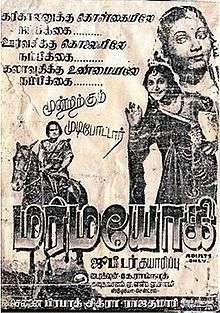Marmayogi
| Marmayogi | |
|---|---|
 Theatrical poster | |
| Directed by | K. Ramnoth |
| Produced by | Jupiter Pictures |
| Written by | A. S. A. Sami |
| Starring |
M. G. Ramachandran M. N. Nambiar S. A. Natarajan Anjali Devi Javar Seetharaman Serukulathur Sama Madhuri Devi |
| Music by |
C. R. Subburaman S. M. Subbaiah Naidu |
| Cinematography |
Masthan W. R. Subbarao |
| Edited by | M. A. Thirumugam |
Release dates | 2 February 1951[1] |
Running time | 175 min. (15,760 feet) |
| Country | India |
| Language | Tamil |
Marmayogi (English: The Mysterious Sage) is a 1951 Indian Tamil fantasy film directed by K. Ramnoth and produced by M. Somasundaram under his banner Jupiter Studios. A film adaptation of the novel Vengeance by Marie Corelli and William Shakespeare's novel Macbeth, the film was shot simultaneously in Hindi as Ek Tha Raja. The film features M. G. Ramachandran, Madhuri Devi and Anjali Devi in the lead roles with Pandari Bai, M. N. Nambiar and S. V. Sahasranamam playing supporting roles.
Development of the film began after the success of Rajakumari (1947), Ramachandran approached writer A. S. A. Sami to write a script which revolves around him. Samy wrote a script inspired from Vengeance by Marie Corelli and Shakespeare's novel Macbeth and Robinhood. S. M. Subbaiah Naidu and C. R. Subbaraman composed all the songs in the soundtrack album. Masthan and Subbarao handled the film's cinematography. The film was edited by M. A. Thirumugam.
The film was released on 2 February 1951 with reel length of 4,804 metres (15,761 ft). The film became commercial success at box office and established Ramachandran's image as a star. It was the first Tamil film to receive an "A" (Adults Only) certificate from the Central Board of Film Certification.
Plot
A King's (Serukalathur Sama) mistress (Anjali Devi) usurps his power and casts him adrift in a river. The two princes of the kingdom (Sahasranamam and MGR) are denied their birthright. The deposed king wanders the country in the guise of a sage. The younger prince (Ramachandran) leads a popular rebellion against the usurper-queen and restores the kingdom to his father.
Cast
- M. G. Ramachandran
- S. A. Natrajan
- M. N. Nambiar
- Anjali Devi
- Javar Seetharaman
- Serukulathur Sama
- S. V. Sahasranamam
- Madhuri Devi
- Pandari Bai
- M. S. S. Bhagyam
Production
After the success of Rajakumari (1947), Ramachandran approached writer A. S. A. Sami to write a script which revolves around him. Samy wrote a script inspired from Vengeance by Marie Corelli and Shakespeare's novel Macbeth and Robinhood.[2][3] Makers initially considered naming the film as Karikalan but later changed it as Marmayogi to avoid it being confused as a historical film.[2] P. Bhanumathi was originally signed for the role of Urvasi later she was replaced by Anjali Devi.[3] Serukulathur Sama, Sahasranamam and S. A. Natarajan were selected to portray supporting roles. M. N. Nambiar portrayed a positive character of Ramachandran's assistant. Masthan and Subbarao handled the film's cinematography. The film was edited by M. A. Thirumugam.
Ramachandran's sword fight sequence with Sahasranamam was shot in outdoors with Ramachandran practised himself for the scene within 3 to 4 days and refused to use body double. Director Ramnath changed the climax from the original screenplay. After the film was completed, many felt that ending was not convincing and Ramnath reshot the climax which was accepted by audience.[3]
Themes and influences
The film's plot was inspired from Vengeance by Marie Corelli and Shakespeare's novel Macbeth.[2][3] The film drew inspiration from Russian film Ivan The Terrible (1944) and the scene where Karikalan enters the courtroom was inspired from the film Adventures of Robin Hood (1938).[3] The scene where Ramachandran fight with sword with Sahasranamam by riding a horse is inspired from Black Arrow.[3]
Soundtrack
The music was composed by S. M. Subbaiah Naidu and C. R. Subburaman. According to page 88 of G. Dhananjayan's 2014 book Pride of Tamil Cinema, only two songs were written for the film: "Kazhuthailiye Irandu Vitham" and "Thillalangadi Thillalangadi".[3] Page 89 of the same book contradicts this, stating that the film had at least five songs, including "Azhagana Penn Maanai Paar", "Desam Pora Pokka Partha, Pesa Kooda Nalla Illae", "Inbam Iravil Amaidhiyile", "Kannin Karumaniye Kalavathi" and "Vetri Sangai Oothuvom".[4]
Release
The film's inaugural show was held at Prabhat Theatre which was commenced by Jayaprakash Narayanan. The film was released on 2 February 1951 with reel length of 4,804 metres (15,761 ft).[1] The film was certified "A" because it featured a ghost. Jupiter Pictures remade the film in Telugu with same name starring N. T. Rama Rao.[4]
Legacy
The film's commercial success established Ramachandran's image as a star.[2][4] It was the first Tamil film to receive an "A" (Adults Only) certificate from the censor board.[4] The dialogue "Karikalan kuri vaithaal thavara maatten! Thavarumey aanaal kuri vaikka maatten" (English: If I aim, it will not fail; if it will fail, I will not aim) became popular and paved way for the trend of inclusion of punch dialogues in Tamil films.[3]
References
External links
- Marmayogi at the Internet Movie Database
Bibliography
- Rajadhyaksha, Ashish; Willemen, Paul (1994). Encyclopaedia of Indian cinema. British Film Institute. p. 302. ISBN 0-85170-455-7, ISBN 978-0-85170-455-5.
- Film News Anandan (2004). Sadhanaigal padaitha Tamil Thiraipada Varalaaru (in Tamil). Chennai: Sivagami Publications. pp. 28:57.
- Pandian, M. S. S (1992). The image trap: M.G. Ramachandran in film and politics. Sage. p. 45. ISBN 0803994036, ISBN 978-0-8039-9403-4.
- Baskaran, S. Theodore (1996). The eye of the serpent: an introduction to Tamil cinema. Chennai: East West Books. p. 180.
- Dhananjayan, G. (2014). Pride of Tamil Cinema: 1931 to 2013. Blue Ocean Publishers. ISBN 978-93-84301-05-7.